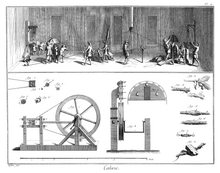Henri-Louis Duhamel du Monceau
Appearance
Henri-Louis Duhamel du Monceau (20 July 1700, Paris – 13 August 1782, Paris), was a French physician, naval engineer and botanist.
Quotes
[edit]- There is nobody who is not surprised of the small price of pins; but we shall be even more surprised, when we know how many different operations, most of them very delicate, are mandatory to make a good pin. We are going to go through these operations in a few words to stimulate the curiosity to know their detail; this enumeration will supply as many articles which will make the division of this work... The first operation is to have brass go through the drawing plate to calibrate it.
- Henri-Louis Duhamel du Monceau (1776) l’"Art de l’Épinglier" (The Art of the Pin-Maker). Introduction
Quotes about Henri-Louis Duhamel du Monceau
[edit]- This Duhamel has invented an infinity of machines which serve no purpose, has written and translated a multitude of books on agriculture, of which it is not known if they have any useful result, that is still awaited.
- Denis Diderot, Oeuvres complètes de Diderot: revues sur les éditions originales, comprenant ce qui a été publié à diverses époques et les manuscrits inédits, conservés à la Bibliothèque de l'Ermitage, notices, notes, table analytique, Volume 11. Garnier frères, 1767. p. 366

- Though he loved many innovations in science and devoted his life to introduce useful ones in the arts, he didn't like them in politics and even less in the statutes of the academies
- Marquis de Condorcet. Tribute to Duhamel du Monceau, April 30, 1783
- New “agronomy,” [was] an experimental science of agriculture founded around midcentury by the chemist and botanist Henri-Louis Duhamel du Monceau
- Jessica Riskin (2002), Science in the Age of Sensibility: The Sentimental Empiricists of the French Enlightenment. p. 119
- The French botanist and chemist Henri-Louis Duhamel de Monceau (1700–1782) identified a fungal disease on the bulbs of saffron crocus (now named Helicobasidium purpureum) and illustrated its sclerotia on the bulbs. His report was read to the Academie royale des Sciences in April 1728; it was “wellconceived, thorough, and conclusive, and led to his election as adjoint chimiste in the same year” (Eklund 1971:223). Duhamel discovered that this fungus spreads underground from one bulb to another. In his Éléments d’agriculture (two volumes, 1762; English edition, 1764), he also accepted insects as a cause of some plant diseases.
- Joseph Pitton de Tournefort, "A History of the Ecological Sciences, Part 29: Plant Disease Studies During the 1700s." in: Bulletin of the Ecological Society of America, July 2008, p. 231-242.

